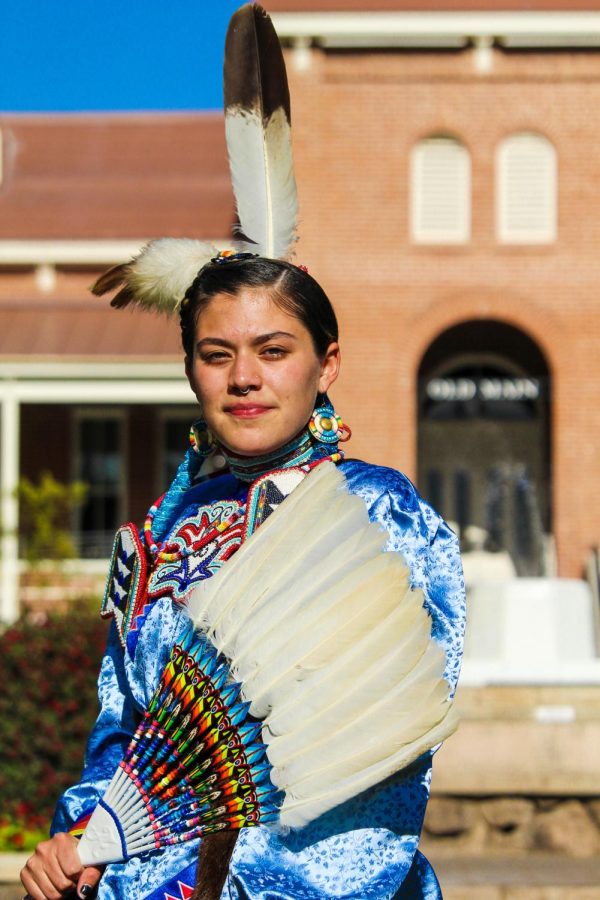OPINION: The University of Arizona is throwing money at an issue that goes much deeper than the school’s pockets
Alexandria Decorah, a member of the Forest County Potawatomi tribe in Wisconsin and a student at the University of Arizona.
June 20, 2023
“We respectfully acknowledge the University of Arizona is on the land and territories of Indigenous peoples.”
A vast majority of emails from the University of Arizona include this statement like a piece of fine print at the end. The territories it is referencing are those of the Tohono O’odham and Pascua Yaqui tribes. In addition to this sort of tagline included at the end of its emails, the UA also has a web portal called “Native American Advancement, Initiatives and Research,” permanent flag installations to honor Indigenous nations and various financial benefits for certain tribes.
Though the university has many technical installments in place to honor the Indigenous community, I believe the way we can tell whether or not these are actually impactful is by asking the people this directly affects — Indigenous faculty and students at the UA. According to the UA’s fall 2022 census, 2.4% of the faculty and 3.5% of the students are Indigenous. Arizona’s population as a whole is made up of 6% Indigenous people, according to that same census report. Despite this being an overall smaller demographic on campus, the university recognizes that because it is on tribal land, it is a demographic that needs to be recognized.
I talked with students and faculty members to gain some insight into what Indigenous people affiliated with the university think.
I spoke to Taylen Yazzie, who is a member of the Diné (Navajo) tribe which lies mostly within Arizona state lines. When the university announced its Arizona Native Scholars Grant, which gives free tuition to members of an Arizonan tribe, it was great news for many.
“It was all over the Navajo Times,” Yazzie said, “we all thought this was big news.”
According to Emma Hall, in her article, “Colleges are making tuition free for Native students. Will more students graduate?” grants and tuition coverage like this are a massive leg up for the Indigenous community. A major source of help for college students paying tuition is what their family is able to contribute, and in a 2020 survey, it was reported that “51% of Native students had an expected family contribution […] at 0%.” So, the main source of financial help is nothing. This fact, as well as many others, thoroughly proves that finances are a significant barrier in the lives of Indigenous people.
So, in terms of financial help, the UA is offering a generous helping hand to the native community. But it’s just on a surface level.
As Yazzie pointed out, tuition is only one of many fees students are expected to pay for. This is true, and covering all of the extra fees, when taking at least 12 units, can rack up to over $1,000 in addition to tuition. While $1,000 could be a manageable amount for some people, for many Indigenous students whose families cannot contribute, this could be a deal breaker.
In addition to what the UA says it does for funding, the university prides itself on being an inclusive campus.
“Committed to diversity and inclusion, the University strives to build sustainable relationships with sovereign Native Nations and Indigenous communities through education offerings, partnerships, and community service.”
This statement lies at the bottom of the university’s native outreach website. The education offerings are visible through the financial benefits that the university offers, but there are a few other components within this that are worth reviewing. I spoke with Alexandria Decorah, a member of the Forest County Potawatomi tribe in Wisconsin and a student at the UA. In Decorah’s case, her education is being funded by her tribe, as she does not qualify for the benefits.
“[The university’s values] really lean more towards Greek Life,” Decorah said. In an exchange with a fellow student, Decorah said she was told, “I didn’t know Native Americans were civilized,” and that their lifestyle was akin to how it is portrayed in old Western movies. For a campus that prides itself on diversity and inclusion, there seems to be a lack of knowledge about Indigenous people within the student body.
The UA is partnered with the Pascua Yaqui tribe as well as the Tohono O’odham Nation, and its financial benefits specific to the Indigenous community are impactful. According to a June 2022 AZ Mirror article by Shondiin Silversmith, the Tohono O’odham Nation Chairman Ned Norris Jr. said, “This program will help ensure that students from the Nation and other tribes have the opportunity to access the world-class education opportunity available close to home at the University of Arizona.”
Money clearly goes a long way, but according to Indigenous students at the UA, there are things other than money that could be implemented on campus. Indigenous culture fairs on the UA Mall, a more accessible Indigenous outreach team and more community-building opportunities are among some of the ideas students, Indigenous and not, have had.
The University of Pittsburgh, for example, hosts an Indigenous Cultural Festival that involves a Pow Wow with lessons on Indigenous art.
Money is a great help, but a sense of community is vital for the Indigenous community’s ability to thrive. “I am an immigrant in my own country,” Yazzie said, “I am not just representing myself when I am off of the reservation, I am representing my community.”
Being able to find a new Indigenous community on campus, participation in hosting and organizing cultural events and better educating UA students on Indigenous communities is a must.
The UA has the money, but does it have the morals?
Follow the Daily Wildcat on Twitter

Olivia Malone is a freshman at the UA studying law and journalism, and minoring in family studies and human development. She enjoys being outdoors, making music, and traveling.



